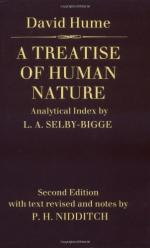I might give as instances those arguments for infinite divisibility, which are derived from the point of contact. I know there is no mathematician, who will not refuse to be judged by the diagrams he describes upon paper, these being loose draughts, as he will tell us, and serving only to convey with greater facility certain ideas, which are the true foundation of all our reasoning. This I am satisfyed with, and am willing to rest the controversy merely upon these ideas. I desire therefore our mathematician to form, as accurately as possible, the ideas of a circle and a right line; and I then ask, if upon the conception of their contact he can conceive them as touching in a mathematical point, or if he must necessarily imagine them to concur for some space. Whichever side he chuses, he runs himself into equal difficulties. If he affirms, that in tracing these figures in his imagination, he can imagine them to touch only in a point, he allows the possibility of that idea, and consequently of the thing. If he says, that in his conception of the contact of those lines he must make them concur, he thereby acknowledges the fallacy of geometrical demonstrations, when carryed beyond a certain degree of minuteness; since it is certain he has such demonstrations against the concurrence of a circle and a right line; that is, in other words, be can prove an idea, viz. that of concurrence, to be incompatible with two other ideas, those of a circle and right line; though at the same time he acknowledges these ideas to be inseparable.
SECT. V. THE SAME SUBJECT CONTINUED.
If the second part of my system be true, that the idea of space or extension is nothing but the idea of visible or tangible points distributed in a certain order; it follows, that we can form no idea of a vacuum, or space, where there is nothing visible or tangible. This gives rise to three objections, which I shall examine together, because the answer I shall give to one is a consequence of that which I shall make use of for the others.
First, It may be said, that men have disputed for many ages concerning a vacuum and a plenum, without being able to bring the affair to a final decision; and philosophers, even at this day, think themselves at liberty to take part on either side, as their fancy leads them. But whatever foundation there may be for a controversy concerning the things themselves, it may be pretended, that the very dispute is decisive concerning the idea, and that it is impossible men coued so long reason about a vacuum, and either refute or defend it, without having a notion of what they refuted or defended.




